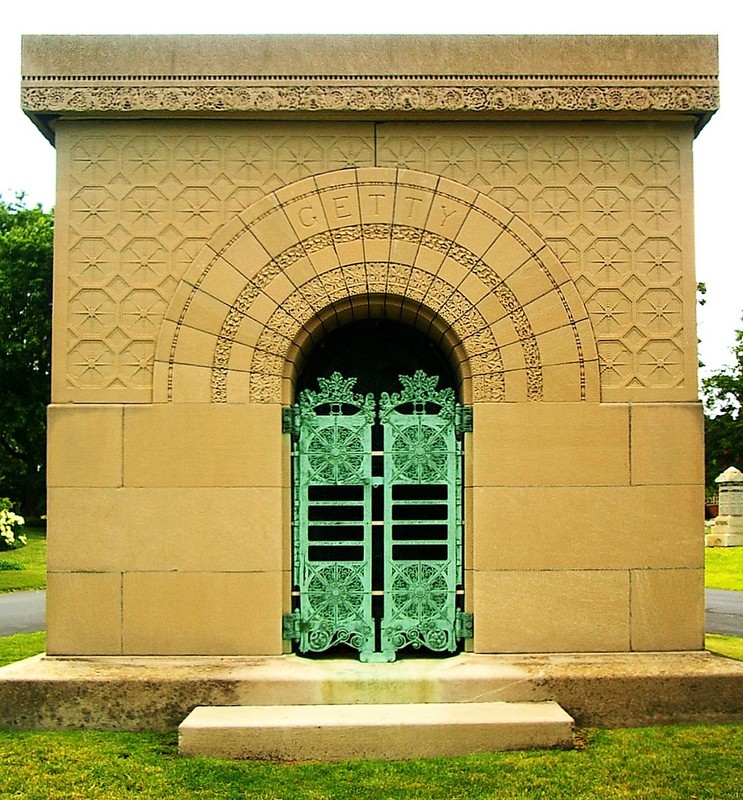Carrie Eliza Getty Tomb (Getty Family Mausoleum) in Graceland Cemetery
Introduction
Text-to-speech Audio
Celebrated architect Louis Henry Sullivan was commissioned to design the Getty Family Mausoleum in 1890 within Chicago's Graceland Cemetery. Sullivan became a leading figure in modern American architecture during the late nineteenth century and early twentieth century, notably the Chicago School's skyscraper design as well as the Praire School design aesthetic that emphasized horizontal lines. Sullivan built the tomb for Carrie Getty at the request of her husband, lumber magnate Henry Harrison Getty, who is buried here along with their daughter.
Images
Getty Tomb

Backstory and Context
Text-to-speech Audio
Although partially educated at the historically oriented Ecole des Beaux-Arts in Paris, Sullivan developed into one of the nation's most influential architects. His architectural philosophy included a rejection of historical precedents, which resulted in unique designs and ornamentation. His work proved integral to the development of the Chicago School (during the birth of the modern skyscraper) and later the Prairie School, which his student, Frank Lloyd Wright, embraced and made famous. Although Sullivan enjoyed a prestigious career and now enjoys historical fame, he died in poverty in 1924. An economic depression during the 1890s led to a significant decline in Sullivan's work. Still, shortly before he died, he published The Autobiography of an Idea. Construction of this tomb began in 1890 at the height of his career when he designed noteworthy buildings throughout Chicago, many of which still stand today.
Sullivan built the tomb for Carrie Eliza Getty, the deceased wife of Henry Harrison Getty, a prominent Chicago lumber magnate. Lumber existed as one of Chicago's early "big three" commodities during the late nineteenth century, along with grain and meatpacking. With the growing city's proximity to Lake Michigan, canals that connected the Great Lakes to the Mississippi River, railways, and the dense forests of the Upper Great Lakes (which the industry eventually exhausted), Chicago supported the world's most prosperous lumber market; people like Henry Getty helped turn those environmental advantages into massive profits.
The tomb can be found in Chicago's renowned Graceland Cemetery where numerous high-profile figures are buried. (see: The Clio Project entry at https://www.theclio.com/entry/13905.) Sullivan himself is buried a short distance from the historic tomb he designed. The tomb survives both as a reminder of Sullivan during the peak of his career and also the significance of Chicago's lumber industry (and the Getty's role in that) during the Gilded Age and into the early twentieth century.
Sources
Brosnan, Kathleen A., Ann Durkin Keating, and William C. Barnett, eds. City of Lake and Prairie: Chicago's Environmental History. Pittsburgh: University of Pittsburgh Press, 2020.
"Carrie Eliza Anderson Getty." Find a Grave. findagrave.com. Accessed November 6, 2023. https://www.findagrave.com/memorial/40440199/carrie-eliza-getty.
Cronon, William. Nature's Metropolis: Chicago and the Great West. New York: W. W. Norton, 1991.
Dovilas, Henry. "Nomination Form: Getty Tomb." National Register of Historic Places. nps.gov. 1974. https://catalog.archives.gov/id/28892220.
Elstein, Rochelle Berger. "Adler & Sullivan: The End of the Partnership and Its Aftermath." Journal of the Illinois State Historical Society (1998-) 98, no. 1/2 (2005): 51–81.
Koeper, H.F. "Louis Sullivan: American architect." Britannica. Accessed November 6, 2023. https://www.britannica.com/biography/Louis-Sullivan/Legacy.
Lowe, David Garrard. "Louis Henri Sullivan and the Chicago School." The Electronic Encyclopedia of Chicago. 2005. http://www.encyclopedia.chicagohistory.org/pages/2414.html.
--- --- ---. "Architecture: The First Chicago School." The Electronic Encyclopedia of Chicago. 2005. http://www.encyclopedia.chicagohistory.org/pages/62.html.
By David Gleason (mindfrieze) - Self-photographed, CC BY-SA 3.0, https://commons.wikimedia.org/w/index.php?curid=914634
